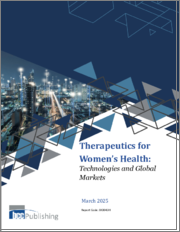
|
시장보고서
상품코드
1609835
일본의 여성 건강 시장 보고서 : 연령층 유형, 용도, 유통 채널, 지역별(2024-2032년)Japan Women´s Health Market Report by Age Group Type, Application, Distribution Channel, and Region 2024-2032 |
||||||
일본의 여성 건강 시장의 시장 규모는 2023년에 24억 1,900만 달러에 달했습니다. 향후 IMARC Group은 시장이 2032년까지 32억 7,800만 달러에 달하며, 2024-2032년 3.4%의 성장률(CAGR)을 보일 것으로 예측하고 있습니다. 로봇 지원 수술, 저침습수술, 원격의료 등 의료 기술의 진보가 진행되며, 여성 건강 상태의 진단이나 치료 옵션이 증가한 것이 주로 시장을 촉진하고 있습니다.
본 리포트에서 답변하는 주요 질문
- 일본의 여성 건강 시장은 지금까지 어떻게 추이해 왔으며, 향후 어떻게 추이하는가?
- COVID-19가 일본의 여성 건강 시장에 미친 영향은?
- 일본의 여성 건강 시장의 연령층별 내역은?
- 일본의 여성 건강 시장의 용도별 내역은?
- 일본의 여성 건강 시장의 유통 채널별 내역은?
- 일본의 여성 건강 시장의 밸류체인에는 어떤 단계가 있는가?
- 일본의 여성 건강에 관한 주요 촉진요인과 과제는 무엇인가?
- 일본의 여성 건강 시장의 구조와 주요 기업은?
- 일본의 여성 건강 시장에서 경쟁의 정도는?
목차
제1장 서문
제2장 조사 범위와 조사 방법
- 조사의 목적
- 이해관계자
- 데이터 소스
- 시장 추정
- 조사 방법
제3장 개요
제4장 일본의 여성 건강 시장 : 서론
- 개요
- 시장 역학
- 업계 동향
- 경쟁 정보
제5장 일본의 여성 건강 시장 구도
- 과거 및 현재 시장 동향(2018-2023년)
- 시장 예측(2024-2032년)
제6장 일본의 여성 건강 시장 : 연령층 유형별 내역
- 50세 이상
- 기타
제7장 일본의 여성 건강 시장 : 용도별 내역
- 피임약
- 골다공증
- 폐경
- 불임
- 기타
제8장 일본의 여성 건강 시장 : 유통 채널별 내역
- 병원 약국
- 소매 약국
- 온라인 약국
제9장 일본의 여성 건강 시장 : 경쟁 구도
- 개요
- 시장 구조
- 시장 기업 포지셔닝
- 주요 성공 전략
- 경쟁 대시보드
- 기업 평가 상한
제10장 주요 기업의 개요
제11장 일본의 여성 건강 시장 : 업계 분석
- 촉진요인·억제요인·기회
- Porter's Five Forces 분석
- 밸류체인 분석
제12장 부록
KSA 24.12.24Japan women's health market size reached US$ 2,419.0 Million in 2023. Looking forward, IMARC Group expects the market to reach US$ 3,278.0 Million by 2032, exhibiting a growth rate (CAGR) of 3.4% during 2024-2032. The increasing advances in medical technology, such as robotic-assisted surgery, minimally invasive procedures, and telemedicine, which have improved the diagnosis and treatment options available for women's health conditions, are primarily driving the market.
Women's health refers to the unique physical, mental, and emotional well-being of women across their lifespan. It encompasses a wide range of issues, including reproductive health, sexual health, and overall physical fitness. Key aspects of women's health include menstrual and menopausal health, pregnancy and childbirth, contraception, breast health, and gynecological care. Regular check-ups, screenings, and access to healthcare are essential to maintaining women's health. This includes Pap smears, mammograms, and discussions about family planning. Mental health is also crucial, as women are more susceptible to conditions like depression and anxiety. A healthy lifestyle, including a balanced diet, regular exercise, and stress management, plays a significant role in women's health. Additionally, promoting gender equality and addressing societal factors that affect women's health, such as discrimination and unequal access to healthcare, are essential steps toward ensuring that women can lead healthy and fulfilling lives. Women's health is a multifaceted and critical aspect of public health, deserving attention and support.
Japan Women's Health Market Trends:
The women's health market in Japan is multifaceted and interconnected, driven by various factors that collectively shape the landscape of healthcare for women. Firstly, advances in medical research and technology have significantly propelled the women's health market forward. Breakthroughs in diagnostic tools, such as mammography and genetic testing, have enhanced the early detection of diseases like breast cancer and hereditary conditions, improving overall health outcomes. Secondly, the growing awareness of women's unique healthcare needs has played a pivotal role. Women are increasingly informed about the importance of preventive care, leading to higher demand for gynecological services, contraceptives, and maternity care. Furthermore, societal shifts, including delayed childbirth and an aging female population, have contributed to the expansion of this market. These shifts require tailored healthcare solutions, driving innovation and investment in women's health services. Moreover, various regulatory changes and government initiatives improve access to healthcare through several policies, thereby enhancing the affordability and availability of women's health services. This, in turn, is expected to drive the women's health market in Japan during the forecast period.
Japan Women's Health Market Segmentation:
Age Group Type Insights:
50 Years and Above
- Postmenopausal Osteoporosis
- Endometriosis and Uterine Fibroids
- Menopause
- Others
Application Insights:
- Contraceptives
- Osteoporosis
- Menopause
- Infertility
- Others
Distribution Channel Insights:
- Hospital Pharmacies
- Retail Pharmacies
- Online Pharmacies
Competitive Landscape:
The market research report has also provided a comprehensive analysis of the competitive landscape. Competitive analysis such as market structure, key player positioning, top winning strategies, competitive dashboard, and company evaluation quadrant has been covered in the report. Also, detailed profiles of all major companies have been provided.
Key Questions Answered in This Report:
- How has the Japan women's health market performed so far and how will it perform in the coming years?
- What has been the impact of COVID-19 on the Japan women's health market?
- What is the breakup of the Japan women's health market on the basis of age group type?
- What is the breakup of the Japan women's health market on the basis of application?
- What is the breakup of the Japan women's health market on the basis of distribution channel?
- What are the various stages in the value chain of the Japan women's health market?
- What are the key driving factors and challenges in the Japan women's health?
- What is the structure of the Japan women's health market and who are the key players?
- What is the degree of competition in the Japan women's health market?
Table of Contents
1 Preface
2 Scope and Methodology
- 2.1 Objectives of the Study
- 2.2 Stakeholders
- 2.3 Data Sources
- 2.3.1 Primary Sources
- 2.3.2 Secondary Sources
- 2.4 Market Estimation
- 2.4.1 Bottom-Up Approach
- 2.4.2 Top-Down Approach
- 2.5 Forecasting Methodology
3 Executive Summary
4 Japan Women's Health Market - Introduction
- 4.1 Overview
- 4.2 Market Dynamics
- 4.3 Industry Trends
- 4.4 Competitive Intelligence
5 Japan Women's Health Market Landscape
- 5.1 Historical and Current Market Trends (2018-2023)
- 5.2 Market Forecast (2024-2032)
6 Japan Women's Health Market - Breakup by Age Group Type
- 6.1 50 Years and Above
- 6.1.1 Overview
- 6.1.2 Historical and Current Market Trends (2018-2023)
- 6.1.3 Market Segmentation
- 6.1.3.1 Postmenopausal Osteoporosis
- 6.1.3.2 Endometriosis and Uterine Fibroids
- 6.1.3.3 Menopause
- 6.1.4 Market Forecast (2024-2032)
- 6.2 Others
- 6.2.1 Historical and Current Market Trends (2018-2023)
- 6.2.2 Market Forecast (2024-2032)
7 Japan Women's Health Market - Breakup by Application
- 7.1 Contraceptives
- 7.1.1 Overview
- 7.1.2 Historical and Current Market Trends (2018-2023)
- 7.1.3 Market Forecast (2024-2032)
- 7.2 Osteoporosis
- 7.2.1 Overview
- 7.2.2 Historical and Current Market Trends (2018-2023)
- 7.2.3 Market Forecast (2024-2032)
- 7.3 Menopause
- 7.3.1 Overview
- 7.3.2 Historical and Current Market Trends (2018-2023)
- 7.3.3 Market Forecast (2024-2032)
- 7.4 Infertility
- 7.4.1 Overview
- 7.4.2 Historical and Current Market Trends (2018-2023)
- 7.4.3 Market Forecast (2024-2032)
- 7.5 Others
- 7.5.1 Historical and Current Market Trends (2018-2023)
- 7.5.2 Market Forecast (2024-2032)
8 Japan Women's Health Market - Breakup by Distribution Channel
- 8.1 Hospital Pharmacies
- 8.1.1 Overview
- 8.1.2 Historical and Current Market Trends (2018-2023)
- 8.1.3 Market Forecast (2024-2032)
- 8.2 Retail Pharmacies
- 8.2.1 Overview
- 8.2.2 Historical and Current Market Trends (2018-2023)
- 8.2.3 Market Forecast (2024-2032)
- 8.3 Online Pharmacies
- 8.3.1 Overview
- 8.3.2 Historical and Current Market Trends (2018-2023)
- 8.3.3 Market Forecast (2024-2032)
9 Japan Women's Health Market - Competitive Landscape
- 9.1 Overview
- 9.2 Market Structure
- 9.3 Market Player Positioning
- 9.4 Top Winning Strategies
- 9.5 Competitive Dashboard
- 9.6 Company Evaluation Quadrant
10 Profiles of Key Players
- 10.1 Company A
- 10.1.1 Business Overview
- 10.1.2 Product Portfolio
- 10.1.3 Business Strategies
- 10.1.4 SWOT Analysis
- 10.1.5 Major News and Events
- 10.2 Company B
- 10.2.1 Business Overview
- 10.2.2 Product Portfolio
- 10.2.3 Business Strategies
- 10.2.4 SWOT Analysis
- 10.2.5 Major News and Events
- 10.3 Company C
- 10.3.1 Business Overview
- 10.3.2 Product Portfolio
- 10.3.3 Business Strategies
- 10.3.4 SWOT Analysis
- 10.3.5 Major News and Events
- 10.4 Company D
- 10.4.1 Business Overview
- 10.4.2 Product Portfolio
- 10.4.3 Business Strategies
- 10.4.4 SWOT Analysis
- 10.4.5 Major News and Events
- 10.5 Company E
- 10.5.1 Business Overview
- 10.5.2 Product Portfolio
- 10.5.3 Business Strategies
- 10.5.4 SWOT Analysis
- 10.5.5 Major News and Events
11 Japan Women's Health Market - Industry Analysis
- 11.1 Drivers, Restraints, and Opportunities
- 11.1.1 Overview
- 11.1.2 Drivers
- 11.1.3 Restraints
- 11.1.4 Opportunities
- 11.2 Porters Five Forces Analysis
- 11.2.1 Overview
- 11.2.2 Bargaining Power of Buyers
- 11.2.3 Bargaining Power of Suppliers
- 11.2.4 Degree of Competition
- 11.2.5 Threat of New Entrants
- 11.2.6 Threat of Substitutes
- 11.3 Value Chain Analysis



















